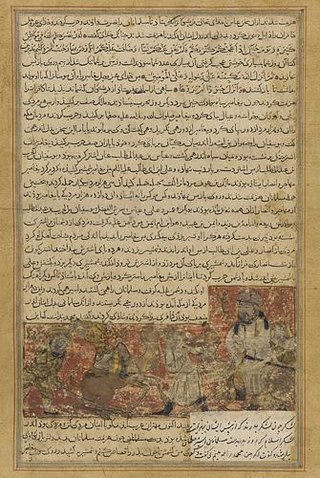Uqba ibn Abi Mu'ayt was one of the principal adversaries of Islam. He was a Quraysh leader and a member of the Banu 'Abdu Shams clan of Quraish tribe.
Khubayb ibn ʿAdiy was a Sahabi (companion) of the Islamic prophet Muhammad. He was killed during the Expedition of Al Raji.
Zayd ibn Ḥāritha al-Kalbī, was an early Muslim, Sahabi and the adopted son of the Islamic prophet, Muhammad. He is commonly regarded as the fourth person to have accepted Islam, after Muhammad's wife Khadija, Muhammad's cousin Ali, and Muhammad's close companion Abu Bakr. Zayd was a slave that Hakim ibn Hizam, Khadija's nephew, bought for her at a market in Ukaz. Zayd then became her and Muhammad’s adopted son. This father-son status was later annulled after Muhammad married Zayd’s ex-wife, Zaynab bint Jahsh.

The Battle of Hunayn was a conflict between the Muslims of the Islamic prophet Muhammad and the tribe of Qays in the aftermath of the conquest of Mecca. The battle took place in 8 AH in the Hunayn valley on the route from Mecca to Taif. The battle ultimately ended in a decisive victory for the Muslims, and it is one of the few battles mentioned by name in the Qur'an, where it appears in Surat at-Tawbah.
When the Islamic prophet Muhammad initially spread Islam in his hometown, Mecca, he did not meet with any significant opposition from his tribesmen, the Quraysh. Rather, they were indifferent to his activities, as they did not appear to be particularly interested in devotional meetings. This was the case until Muhammad started attacking their beliefs, which caused tensions to arise. The Muslims then reportedly received persecution that lasted for twelve years beginning from the advent of Islam to Hijrah.
ʿAaṣim ibn Thābit was one of the Ansar, a person belonging to one of the first generations of Muslims and who helped Muhammad after his migration to Medina.
The Expedition of Qatan, was the first Raid on the Banu Asad bin Khuzaymah tribe, which occurred directly after the Battle of Hamra al-Asad in the year 4 A.H of the Islamic calendar.
The early Muslim–Meccan conflict refer to a series of raids in which the Islamic prophet Muhammad and his companions participated. The raids were generally offensive and carried out to gather intelligence or seize the trade goods of caravans financed by the Mushrik of the Quraysh. His followers were also impoverished. The raids were intended to harm the economy and in turn the offensive capabilities of Mecca by Muhammad. The Muslims felt that the raids were justified in that the items being sold in the caravans were their own items, stolen by the Meccans when they had fled to Medina.
Umm Qirfa Fatima was a leader of the Banu Fazara Arab tribe from Wadi al-Qura.
The Al-Qarada raid was an event in early Islamic history which took place in Jumad at Thaniya, in the year 3 A.H of the Islamic calendar, i.e. November 624.
The Expedition of Abdullah ibn Unais, also known as the Assassination of Khaled bin Sufyan was the first attack against the Banu Lahyan, which took place in the month of Muharram in the year A.H. 3. It was reported that Khaled bin Sufyan Al-Hathali, considered an attack on Madinah and that he was inciting the people on Nakhla or Uranah to fight Muslims. So Muhammad sent Abdullah ibn Unais to assassinate him. After cutting off Khaled bin Sufyan's head at night, Unais brought it back to Muhammad.
The Expedition of Bir Maona, according to Islamic tradition, took place four months after the Battle of Uhud in the year A.H. 4 of the Islamic calendar. It is believed the Islamic prophet Muhammad sent missionaries to preach Islam, at the request of Abu Bara. Forty or seventy of the Muslim missionaries sent by Muhammad were killed.
The Expedition of Badr al-Maw'id was the third time Muhammad led an expedition in Badr. Modern historians date the event to October 625, though several alternative dates are found in primary sources.
The Expedition of Muhammad ibn Maslamah took place in July, 627 AD in Muharram, 6AH.

Expedition of Zayd ibn Harithah in Hisma took place in October, 628, 6th month of 7AH of the Islamic calendar. The attack led by Zayd ibn Harithah was a response to Dihyah bin Khalifa Kalbi's call for help, after being attacked by robbers. Muslims retaliated and killed many of the robbers and captured 100 tribe members
The Expedition of al-Muraysiʿ was an early Muslim campaign against the tribe of Banu Mustaliq which took place in December 627 CE.

Safiur Rahman Mubarakpuri was an Indian Islamic scholar, teacher and writer within the Salafi creed. His book Ar-Raheeq Al-Makhtum, won a prize at the first Islamic conference on seerah Muslim World League in 1978.
Zayd bin al-Dathinnah was a companion of the Islamic Prophet Muhammad. He was killed during the Expedition of Al Raji. In 625 some men requested that Muhammad send instructors to teach them Islam, but the men were bribed by the two tribes of Khuzaymah who wanted revenge for the assassination of Khalid bin Sufyan by Muhammad's followers and they killed the Muslims
Uqba bin al-Harith was a companion of Muhammad, but used to be an enemy of him when he was a Pagan. According to the Muslim scholar Safiur Rahman Mubarakpuri, when he was still a Pagan, the Quraysh ordered Khubyab bin Adi to be crucified by Uqba bin al-Harith during the Expedition of Al Raji, because he had killed Uqba bin al-Harith's father.
Amr bin Umayyah al-Damri was a companion of the Islamic Prophet Muhammad. Amr bin Umayyah al-Damri was sent to assassinate Abu Sufyan.


